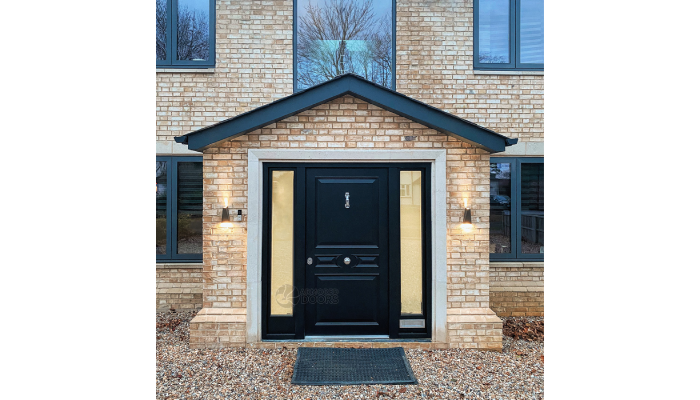
How to Measure for a Custom Security Door?
Measuring for a custom security door is important to ensure it fits tight and secure, preventing any gaps that could be weaknesses. You’ll need tools like a steel measuring tape, pencil, and paper, and having someone help can make the process easier and more accurate. Start by clearing the doorway to avoid mistakes. Measure width at three spots, top, middle, bottom, and record the smallest number. Do the same for height from floor to frame top. Don’t forget jamb depth for frame thickness and note which way the door swings. Double-check all measurements before ordering to avoid issues later on.
Significance of Accurate Door Measurements
Accurate measurement of custom security doors are crucial when ordering a custom security door to ensure it fits perfectly within the frame. Measuring the width, height, and depth carefully helps avoid gaps that could compromise security or cause operational issues. It’s important to take multiple measurements at different points and use the smallest width and height numbers to account for any irregularities, like uneven walls or sloped floors. Even small errors can lead to problems with door alignment, making it difficult to open or close properly. Measuring the jamb depth correctly ensures you select a door frame that matches your wall thickness, which is essential for both appearance and function. Avoid relying on the size of a previous door; always measure the actual opening to prevent costly returns or modifications after purchase. Clear, precise measurements also help you choose the right door style and frame thickness, improving the door’s overall durability and security. Documenting these measurements clearly reduces confusion during ordering and installation, making the entire process smoother and more reliable.
Essential Tools and How to Prepare?
Before measuring for a custom security door, gather the right tools to ensure accuracy. Use a steel or rigid measuring tape since it stays straight and provides more stable measurements than a flexible one. Have a pencil or marker and a notepad ready to record your numbers immediately to avoid forgetting any details. Clear the doorway area of furniture, rugs, or other obstacles that could interfere with your measurements or cause you to misread dimensions. If possible, have a helper hold one end of the tape measure to keep it steady and make the process smoother. Check that your tape measure isn’t stretched or damaged, as this can lead to inaccurate results. Good lighting is essential so you can clearly see all marks and measurements, preventing mistakes. Depending on your floor type, decide whether to wear shoes or remove them to avoid mistakes in height measurements caused by added or reduced height. Using a level can help identify if the floor or frame is uneven, which is important to note since it might affect how the door fits. Before starting, review any specific measurement instructions from the door manufacturer to follow their guidelines precisely. Finally, prepare to measure multiple points, width, height, and depth, at various spots around the frame to capture the smallest and most accurate dimensions for a secure fit.
- Use a steel or rigid measuring tape for more accurate and stable measurements.
- Have a pencil or marker and paper or notepad ready to record measurements immediately.
- Clear the doorway area from furniture, rugs, and other obstacles before measuring.
- If possible, have a helper hold the tape measure to improve accuracy and ease.
- Review any specific measurement instructions from the door manufacturer before starting.
- Check the condition of tools to ensure the tape measure is not stretched or damaged.
- Wear shoes or remove them depending on the floor surface to avoid height measurement errors.
- Use a level to verify if the frame or floor is uneven, which may affect measurements.
- Ensure good lighting so all markings and measurements are clear and legible.
- Prepare to measure multiple points at width, height, and depth for the most precise data.
Step-by-Step Width Measurement
Start by measuring the inside edge of one door jamb to the inside edge of the opposite jamb at the top of the frame. Use a tape measure that can stretch straight across without bending, and keep it flush against the jamb edges for accuracy. Next, take the same width measurement at the middle and bottom of the door frame. This helps account for any irregularities or out-of-square frames. Record all three measurements immediately to avoid forgetting or mixing them up. Always use the smallest of these three numbers when ordering your custom security door, as this ensures the door will fit without forcing it into an uneven opening. Avoid measuring from the outside edges or any trim, since those can add extra width and lead to an incorrect size. Also, check for any obstructions near the jambs, like switches or vents, and measure the clearance to make sure the door won’t interfere with them. Double-check your measurements by repeating them to confirm consistency, and write them down clearly. This careful approach keeps your custom door fitting snugly and functioning as intended.
How to Measure Door Height Correctly?
To measure door height accurately, start by measuring from the floor or threshold up to the underside of the door stop or frame header. Take three separate measurements: one at the left side, one in the middle, and one at the right side of the frame. Record all three and use the smallest measurement when ordering your custom security door to ensure it fits properly. Be careful not to include weather-stripping, floor mats, or any raised thresholds or ramps in your measurement, as these can skew the height. Make sure the floor is level or note any slope that might affect your measurement. Use a rigid tape measure or a straight ruler to avoid sagging, and hold the tape straight up and down, not at an angle. If you’re measuring an existing door, measure from the floor to the top edge of the door panel instead of the frame. Also, inspect the frame for any warping or damage that could affect the height and make a note of it. Taking these careful steps helps ensure your custom door fits snugly and operates correctly.
Measuring the Door Frame Depth
To measure the door frame depth, start by placing your measuring tape at the innermost edge of the door jamb and extend it to the outermost edge. This measurement reveals the thickness of the door frame required to fit your wall properly. It’s important to take measurements at multiple points along the jamb depth because walls and frames are not always perfectly even. If you find any variation, record the largest measurement to ensure the frame will fit the thickest part. Avoid including trim or molding in this measurement unless specifically instructed, as these do not affect the frame’s fit. Using a square or a straight edge can help you measure more accurately by providing a level guide across uneven surfaces. Compare your depth measurement with the known thickness of your wall, especially if your home uses non-standard materials or has unusual thickness. Matching the frame depth to the wall thickness is crucial to guarantee a secure and proper installation. Additionally, consider the frame series or style options available that correspond to your measured depth to ensure compatibility and aesthetic fit. For example, if your wall depth is 6 inches but one spot measures 6 1/4 inches, choose a frame depth that accommodates 6 1/4 inches to avoid gaps or installation issues.
Determining Door Swing Direction
Determining the door swing direction is an essential step when measuring for a custom security door to ensure proper fit and function. Start by identifying if the door swings inward or outward relative to the room or building. This affects not just installation but also clearance and security features. Next, determine if the door is left-hand or right-hand by standing outside the building and noting which side the hinges are on. If the hinges are on the left, it’s a left-hand door; if on the right, it’s a right-hand door. Mark this clearly to avoid ordering mistakes, since swapping the swing direction can cause costly delays.
Check the space around the door opening to see whether the door swings toward a wall, obstacle, or open space. This helps you measure the clearance needed for the door’s arc, preventing interference with nearby objects. For example, a door that swings outward and opens into a narrow walkway may require special considerations or a different swing type. When dealing with double doors, determine the swing direction for each panel separately, as one or both may swing differently.
Door swing direction also impacts hardware placement like locks, bolts, and handles, so accuracy here ensures security features function properly. Note any special configurations such as an outswing door paired with a storm door, since this combination affects installation and clearance needs. When unsure about the swing type, consult manufacturer diagrams or professionals to confirm, reducing risk of ordering the wrong door. Measuring the arc or clearance needed for the door swing helps avoid operational problems, making this step critical for a secure and functional custom door.
Recording Measurements with Precision
When recording your measurements for a custom security door, clarity and accuracy are key. Always write down each dimension, width, height, and depth, and clearly label where each measurement was taken, such as top, middle, bottom, left, or right side of the frame. Use inches and record values to the nearest 1/16th for the best precision, avoiding any rounding up since smaller sizes tend to fit better. Keep your units consistent throughout; mixing metric and imperial can lead to costly errors. Include notes on the door swing direction and any nearby obstructions that might affect the door’s fit or operation. It’s also helpful to add sketches or photos that highlight measurement points, especially if the space has irregularities or unique features. Always double-check your numbers before submitting them for your order. To avoid losing any data, use a dedicated notebook or a digital device to save your measurements and keep a copy handy for reference during installation. Taking these steps ensures your custom door will fit securely and function properly without delays or adjustments.
Accounting for Irregularities and Door Types
When measuring for a custom security door, it’s important to pay close attention to any irregularities in the doorway that could affect the fit. Floors, walls, and door frames may not always be perfectly even, so take multiple measurements at different points, top, middle, and bottom for width, and left, center, and right for height, to spot any inconsistencies. Look closely for bowing, warping, or damage in the existing frame or opening, as these issues might require adjustments to your measurements or repairs before installation. If your door opening includes architectural details like arches or decorative trim, make sure to factor those into your size to avoid ordering a door that won’t fit properly. For double or sliding doors, measure each panel separately since they often differ in size or mounting needs. The type of door you’re installing, hinged, sliding, single panel, or double panel, will also influence how you take your measurements and what allowances to include. For example, manufacturers may specify extra space for weather stripping or seals, so add those allowances to your recorded dimensions. Don’t forget to account for threshold height or any step-up conditions when measuring height, as this impacts clearance and door operation. If you’re dealing with a non-standard or unusually shaped opening, it’s best to consult a professional or your door supplier to ensure the measurements will result in a secure and snug fit. Adjust your final measurements to accommodate any known irregularities, aiming for the tightest fit possible to maximize security and function.
Verifying Measurements Before Ordering
Before placing your order for a custom security door, it is crucial to re-measure the width, height, and depth of the door frame to confirm your initial readings. Use the smallest width and height measurements recorded at multiple points to ensure the door will fit snugly without gaps. Cross-check these measurements against any existing door or frame dimensions, if available, to catch any discrepancies early. Review the manufacturer’s ordering guidelines carefully to make sure your measurements comply with their requirements, including frame depth and door swing direction. Make sure your notes are complete and legible, clearly indicating any special features or obstructions that could affect installation. Avoid rushing this step, as errors in measurement can lead to costly delays or adjustments. If any part of the measurement process feels unclear or if the doorway has unusual features, consult a professional or your supplier for guidance. Keep all measurement records easily accessible, along with any customized order details, and double-check those specifics before submitting your order to avoid mistakes.
Benefits of Professional Measurement Help
Hiring a professional to measure for your custom security door brings several advantages that can save you time, money, and hassle. Experienced measurers reduce the chance of errors by accurately capturing dimensions, even when dealing with complex or irregular openings that might confuse an untrained eye. They can spot potential installation challenges early on, such as uneven frames or obstacles near the doorway, which helps avoid problems during fitting. Professionals provide detailed measurement reports that align with manufacturer specifications, ensuring your order matches what’s needed for a secure, snug fit. Beyond measurements, they can advise on the best door styles, sizes, and hardware placement based on your opening and security needs. This guidance helps prevent costly returns or modifications caused by incorrect sizing or incompatible door swings. Many services offer measurement guarantees or ongoing support if issues arise after installation, giving you peace of mind throughout the process. For example, if the door swing direction isn’t properly noted, a pro will catch it upfront, preventing ordering a door that opens the wrong way. Overall, professional measurement services streamline ordering and installation, making the entire experience smoother and more reliable.



